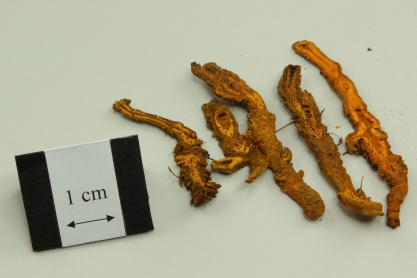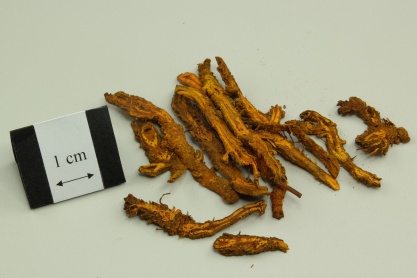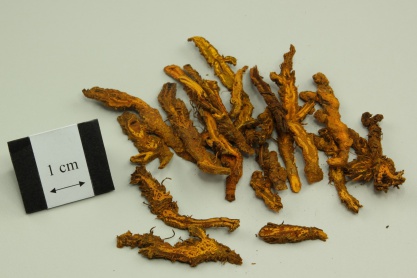- ENG
- Golden thread
- LATIN
- Coptidis Rhizoma
| Medicinal Group | Heat-clearing and dampness-drying medicinal |
|---|---|
| Source | Dried rhizome of Coptis chinensis Franch., Coptis deltoidea C.Y. Cheng et Hsiao or Coptis teeta Wall. (Fam. Ranunculaceae) |
| Nature and Flavors | bitter; cold |
| Meridian Affinity | Liver, Heart, Spleen, Gallbladder, Stomach, Large intestine |
| Actions | To remove damp-heat, quench fire and counteract toxin |
Family
Part used
Indications
Attacked by damp-heat manifested by stuffiness and fullness in the abdomen, vomiting and acid regurgitation, dysentery jaundice; high fever accompanied by impaired consciousness; fidget and insomnia due to fire; spitting of blood and epistaxis caused by heat in the blood; bloodshot eyes; toothache; wasting-thirst; carbuncles and sores; external use for eczema and other skin diseases with exudation; pus from the ears
Research Findings
- Coptidis Rhizoma and berberine are highly expected to be effective, safe and affordable treatments for cancer patients. [1]
- Dahuang Huanglian Xiexin decoction could decrease blood glucose and improve type 2 diabetes mellitus symptoms and reduce body weight.[2]
- Qingchang Huashi Recipe was effective and safe in treating active ulcerative colitis patients of inner-accumulation of damp-heat syndrome. [3]
Cautions
Strongly bitter and cold. An overdose or if taken for too long period, it can easily injure the stomach. Should be used with extra care in case of yin defficiency and fluid depletion
Report on adverse effect
Pro-oxidative effects on G6PD-deficient erythrocytes [4]
Reference
Reference
- Wang N, Tan HY, Li L, Yuen MF, Feng Y. (2015). Berberine and Coptidis Rhizoma as potential anticancer agents: Recent updates and future perspectives. J Ethnopharmacol. , 24;176:35-48. doi: 10.1016/j.jep.2015.10.028. Epub 2015 Oct 19.
- Pang B, Guo J, Zhao L, Zhao X, Zhou Q, Tong X. (2016). Retrospective study of Traditional Chinese Medicine treatment of type 2 diabetes mellitus. J Tradit Chin Med. , 36(3):307-13.
- He HH, Shen H, Zheng K. (2012). Observation of the curative effect of qingchang huashi recipe for treating active ulcerative colitis of inner-accumulation of damp-heat syndrome. Zhongguo Zhong Xi Yi Jie He Za Zhi. , 32(12):1598-601.
- Ko CH, Li K, Ng PC, Fung KP, Wong R, Chui KM, Gu G, Yung E, Fok TF (2008) Pro- oxidative effects of Chinese herbal medicine on G6PD- deficient erythrocytes in vitro. TOXICOLOGY IN VITRO, 22, 5, 1222-1227.
- 王桂梅、李玉香、霍紅 (1994)。<黃連素引起固定性藥疹1例>。黑龍江醫學,8。
- 高曉山 (1996)。<黃連致溶血性黃疸毒性的提出和爭議>。中國中醫藥信息雜誌,6。
- 高曉山 (1996)。<黃連致溶血性黃疸毒性的提出和爭議(續)> 。中國中醫藥信息雜誌,7。
- 高曉山、陳馥馨、楊守業、皮曉霞、李建榮、林娜、劉源、王旭華、嚴梅楨、高雨農、汪長生、葉愛蓮、劉克麗、姜國鋒、黃佛生、劉曉龍 (2002)。<黃連致溶血性黃疸毒性及其防治研究綜合報告>。中國中藥雜誌,1。
- 詹瑞林 (1994)。<服黃連引起過敏反應1例>。中國中藥雜誌,1。












